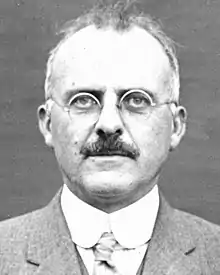Heber Doust Curtis
Heber Doust Curtis (June 27, 1872 – January 9, 1942) was an American astronomer. He participated in 11 expeditions for the study of solar eclipses,[2] and, as an advocate and theorist that additional galaxies existed outside of the Milky Way, was involved in the 1920 Shapley–Curtis Debate concerning the size and galactic structure of the universe.
Heber Doust Curtis | |
|---|---|
 | |
| Born | June 27, 1872 Muskegon, Michigan, U.S. |
| Died | January 9, 1942 (aged 69) Ann Arbor, Michigan, U.S. |
| Nationality | American |
| Alma mater | University of Michigan, University of Virginia |
| Scientific career | |
| Fields | astronomy |
| (23400) A913 CF | February 11, 1913 | MPC |
Biography
Curtis was born on June 27, 1872, the elder son of Orson Blair Curtis and Sarah Eliza Doust.[3]
He studied at the University of Michigan and at the University of Virginia, earning a degree in astronomy from the latter.
From 1902 to 1920 Curtis worked at Lick Observatory, continuing the survey of nebulae initiated by Keeler. He headed up the Lick southern station in Chile from 1905 until 1909, when he returned to take charge of the Crossley telescope.[4] In 1912 he was elected president of the Astronomical Society of the Pacific.
In 1918 he observed Messier 87 and was the first to notice the polar jet which he described as a "curious straight ray ... apparently connected with the nucleus by a thin line of matter."[5][6]
In 1920 he was appointed director of the Allegheny Observatory. In the same year he participated in the Great Debate with Harlow Shapley (also called the Shapley–Curtis Debate) on the nature of nebulae and galaxies, and the size of the universe. Curtis advocated the now-accepted view that other galaxies apart from the Milky Way existed.
Curtis also invented a type of film plate comparator in about 1925, allowing 2 plates, each 8×10 in, to be compared using a set of prisms and placing the plates on stacked and aligned stages rather than next to one another as was the norm, this allowed the body of the device to measure just 60×51 cm. This device is packed in crates and resided at UCO Lick Observatory as of Aug 2011. His article describing the device appears in the Publications of the Allegheny Observatory, vol. VIII, no. 2.
In 1930 Curtis was appointed director of the University of Michigan observatories, but the shortage of funds following the Great Depression prevented the construction of a large reflector he had designed for the university at Ann Arbor. He contributed to develop the McMath–Hulbert private observatory at Lake Angelus.
Curtis was an opponent of Albert Einstein's theory of relativity.[7][8]
He died on January 9, 1942.[2]
Legacy
The Heber Doust Curtis Memorial Telescope at the Portage Lake Observatory was dedicated in 1950 in Curtis' memory. It no longer operates, but remains as a memorial to Curtis.[9][10][11] A small lunar crater east of the larger crater Picard in Mare Crisium received the official name Curtis.
References
- "Minor Planet Discoverers (by number)". Minor Planet Center. 20 June 2016. Retrieved 8 August 2016.
- "Dr. Heber Curtis, An Astronomer, 69. Chairman of Department at the University of Michigan Is Dead in Ann Arbor. Saw 11 Solar Eclipses. Had Served as Head of Lick Observatory in Chile. Won Many Honors for Work". The New York Times. January 10, 1942.
- Hockey, Thomas (2009). The Biographical Encyclopedia of Astronomers. Springer Publishing. ISBN 978-0-387-31022-0. Retrieved August 22, 2012.
- Campbell, W. W. (1911). "D. O. Mills Expedition to the Southern Hemisphere". Popular Astronomy. 19: 84–86. Bibcode:1911PA.....19...84C.
- Heber Doust Curtis (1918). "Descriptions of 762 Nebulae and Clusters Photographed with the Crossley Reflector". Publications of the Lick Observatory. 13: 31. Bibcode:1918PLicO..13....9C. Retrieved 2010-04-26.
- "A Cosmic Blowtorch in Hubble's Viewfinder". New York Times. July 11, 2000. Retrieved 2014-01-12.
Ever since Heber Curtis, a University of California astronomer, spied a ray of light shooting out of M87's core in 1918, astronomers have puzzled over the nature and origin of this jet and dozens of others discovered over the years shooting from the cores of active galaxies and quasars.
- "Curtis versus Einstein". American Astronomical Society Meeting Abstracts. 201st Meeting, 2002.
- Crelinsten, Jeffrey. (2016). Einstein's Jury: The Race to Test Relativity. Princeton University Press. pp. 300-307. ISBN 978-0-691-12310-3
- Charles A. Federer Jr. (June 24, 1950). "Palomr's [sic] Big 'Eye' Maps Far Galaxies". New York Times. Retrieved September 5, 2017.
The symposium is part of the program preceding the dedication tomorrow of the Heber Doust Curtis Memorial Telescope, a $200000 instrument
- "Scientists Will See Dedication". The Michigan Alumnus. 56: 425. June 10, 1950.
- "Heber Doust Curtis Memorial Telescope - Portage Lake Observatory". Waymarking.com. Retrieved September 5, 2017.